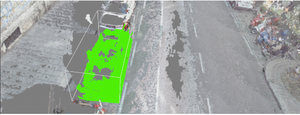Information
- Publication Type: Bachelor Thesis
- Workgroup(s)/Project(s):
- Date: September 2022
- Date (Start): 15. January 2022
- Date (End): 5. September 2022
- Matrikelnummer: 11811340
- First Supervisor:
- Keywords: point clouds, object detection, editing
Abstract
With scanning technologies and the processing power of computers increasing it is getting easier
to scan the surrounding area and upload a 3D model of it. Nowadays mobile phones and drones
are capable of doing that. However, the results most likely are not as good as dedicated scanners.
To offer people an option to explore their scanned objects my colleague Manuel Keilman and
I wrote a software with which users can upload multiple point clouds. Those point clouds can
then be modified by adding, deleting, or moving parts of it. Our primary target is point clouds
of street scenes. We selected an existing classification algorithm called GraND-Net [13] to
identify objects of the scene. Since the classification algorithm does not cluster the classes a
separate algorithm for that was needed. That is why we use DBScan [15] in order to distinguish
different objects of the same class. Both steps are done before starting the application since they
only have to be done once. The benefit of grouping points with similar features is that users
do not have to manually select everything which improves the usability of our software. After
classifying as well as clustering users can upload their point clouds and then select objects in
order to modify them. Mistakes tend to happen which is why our software also offers users the
option to manually classify whatever they want. All of that should make it easier for users to
analyze and modify their point clouds.
Additional Files and Images
Additional images and videos
Additional files
Weblinks
No further information available.
BibTeX
@bachelorsthesis{elagrod_ahmed-baa,
title = "Immersive Redesign",
author = "Ahmed El Agrod",
year = "2022",
abstract = "With scanning technologies and the processing power of
computers increasing it is getting easier to scan the
surrounding area and upload a 3D model of it. Nowadays
mobile phones and drones are capable of doing that. However,
the results most likely are not as good as dedicated
scanners. To offer people an option to explore their scanned
objects my colleague Manuel Keilman and I wrote a software
with which users can upload multiple point clouds. Those
point clouds can then be modified by adding, deleting, or
moving parts of it. Our primary target is point clouds of
street scenes. We selected an existing classification
algorithm called GraND-Net [13] to identify objects of the
scene. Since the classification algorithm does not cluster
the classes a separate algorithm for that was needed. That
is why we use DBScan [15] in order to distinguish different
objects of the same class. Both steps are done before
starting the application since they only have to be done
once. The benefit of grouping points with similar features
is that users do not have to manually select everything
which improves the usability of our software. After
classifying as well as clustering users can upload their
point clouds and then select objects in order to modify
them. Mistakes tend to happen which is why our software also
offers users the option to manually classify whatever they
want. All of that should make it easier for users to analyze
and modify their point clouds.",
month = sep,
address = "Favoritenstrasse 9-11/E193-02, A-1040 Vienna, Austria",
school = "Research Unit of Computer Graphics, Institute of Visual
Computing and Human-Centered Technology, Faculty of
Informatics, TU Wien ",
keywords = "point clouds, object detection, editing",
URL = "https://www.cg.tuwien.ac.at/research/publications/2022/elagrod_ahmed-baa/",
}

 thesis
thesis

